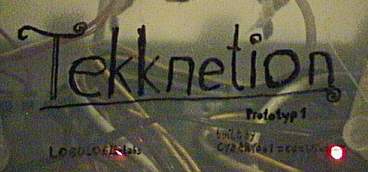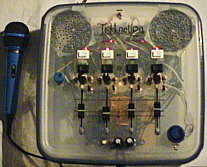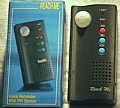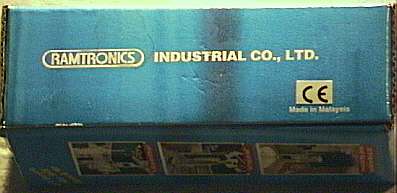 prototype 1
(live performance sampling instrument)
prototype 1
(live performance sampling instrument)
This is the prototype of a gunk repeater, i.e. a live performance instrument
for gunk music. Gunk music is approximately something like a meditative
variant of tekkno trance. (Some gunk music with explanation can be downloaded
here.)
The term "tekknetion" is an acronym that lives somewhere among "tekkno",
"cybernetics" and "accordion". The instrument of that name repeats multiple
(here up to 4) samples in loops and automatically synchronizes them to
an internal optical metronome (the pattern oscillator) to create rhythmic
patterns in a drum- computer- like way. By singing into a microphone, samples
can be generated and looped in realtime, while the others continue playing.
Each of the 4 channels can hold 1 short sample that can be either started
manually or continuously re-started (looped) by the pattern oscillator.
Also the volume and sample frequency of each channel can be changed in
realtime. All functions are accessible by OBS controls. Also the actually
played sound from the other channels can be re-sampled (through the microphone)
in realtime and then e.g. frequency shifted (scratched), which results
often in very chaotic, but gunky sounds (similar like tribal rhythms).
 I
am not sure how far the way this instrument behaves matches the definition
of a "phrase sampler" (which also seems to be a live performance sampling
instrument). I much later also read about an expensive instrument of the
name "Repeater" by Electrix, which also seems to have a very similar
concept like my device. I
am not sure how far the way this instrument behaves matches the definition
of a "phrase sampler" (which also seems to be a live performance sampling
instrument). I much later also read about an expensive instrument of the
name "Repeater" by Electrix, which also seems to have a very similar
concept like my device.
Due to this tekknetion is just a simple, mainly analogue prototype,
it can not save any samples nor patterns for later re-use, but only hold
those up to 4 samples it is currently playing. Also the samples are very
short and lo-fi and have only 6 bit resolution at a few kHz (depending
on the selected sampling frequency). Though basically the sound and concept
of this instrument is not more than "circuit bending to the extreme". |
main features:
-
built-in stereo speakers (2x 2W, with even some bass)
-
sampler bank consisting of 4 independent units those each can record or
playback independently
-
each sampler unit has a playback volume control, record & playback
buttons, frequency slider and level LED
-
each sample can be triggered separately or in 2 modes by the pattern oscillator
-
1 pattern oscillator with optical metronome, 2 tempo control pots and on/off
switch
-
main volume and microphone input level control
-
all controls are OBS
-
stereo output + 4 independent channel output jacks
eastereggs:
When supply voltage is interrupted for some minutes or switched on and
off, the sample data is sometimes partly replaced by a beep or the sample
stop position data gets messed up in a way that the rest of an old and
longer sample gets audible again after overwriting by a shorter one. The
sample frequency slider can also be moved during recording, which results
in a modulated (record scratched) sample.
notes:
This instrument functions mainly analogue and the sample bank was made
from 4 modified "Ramtronics ReachMe" voice reminder devices. These
small, battery operated chip recorders normally can sample 12s of telephone
quality speech and play it back as soon a person enters the room, triggered
by a built-in passive infrared motion sensor (as known from automatic lamps).
Important for the safe operation of an instrument like this is that the
"ReachMe" modules store the data in RAM (buffered by battery + electrolytic
cap). Many similar chip recorders (e.g. the Hallmark Romcorder)
store the data in an EEPROM/ flash memory which can be only overwritten
100'000 times. While this seems to be plenty enough for a normal voice
memo application, it would be way to little for a musical instrument that
continuously repeats (and possibly overwrites) samples in a loop for playing
music. The built-in electret microphone pre- amps of the ReachMe
COB CPU had an automatic volume control which caused a terrible amount
of static noise. After changing some external resistors of the CPU (likely
in an amplifier's feedback loop), the signal needs to be way louder now,
but the noise floor is almost gone. (I anyway use a separate microphone
pre- amplifier for a dynamic microphone to supply all 4 sampler modules.)
The CPU clock frequency is resistor controlled, thus I connected one slide
potentiometer per module to make sample frequency and duration selectable.
(Maximum sample length now varies between something like 0.3 to 20s; the
sample quality behaves vice versa.)
The ReachMe modules needed a separate reset button press to permit
overwriting, thus I connected the reset and record input lines through
a resistor and capacitor to make it possible to record a new sample by
one button press. A green LED (driven through external op-amp) shows the
internal sample playback level to visualize which sound is currently played
on which channel.
A nasty flaw is that the record button must be pressed a moment (e.g.
0.25s) before recording a sample (the exact time depends on selected sample
frequency), otherwise the begin will be missing. The button also needs
to be pressed a little longer than the sample, otherwise the end will be
missing. This makes the use of the instrument prototype way less intuitive.
The samples also start and end with a quiet click; initially the click
was even a loud pop because the battery saving transistor only supplied
the module's small power amp IC with voltage so long a sample was played,
though I re-wired this amp for direct supply and the pop was gone.
Generally this instrument is much fun to experiment with and it can
make a lot of surprising and gunky sounds, but it behaves often little
predictable and to get a desired result out of it is rather difficult.
(But possibly the same sentence could also be spoken by anyone who tries
out a violin and hasn't trained hard to play it. ;-) )
I yet didn't play the tekknetion often, but I plan to use this as the basis
for a (better sounding) software version for PCs.
| removal
of these screws voids warranty... |
|
|
 |

|
|
| |
back
|
|
 I
am not sure how far the way this instrument behaves matches the definition
of a "phrase sampler" (which also seems to be a live performance sampling
instrument). I much later also read about an expensive instrument of the
name "Repeater" by Electrix, which also seems to have a very similar
concept like my device.
I
am not sure how far the way this instrument behaves matches the definition
of a "phrase sampler" (which also seems to be a live performance sampling
instrument). I much later also read about an expensive instrument of the
name "Repeater" by Electrix, which also seems to have a very similar
concept like my device.
 prototype 1
(live performance sampling instrument)
prototype 1
(live performance sampling instrument)


